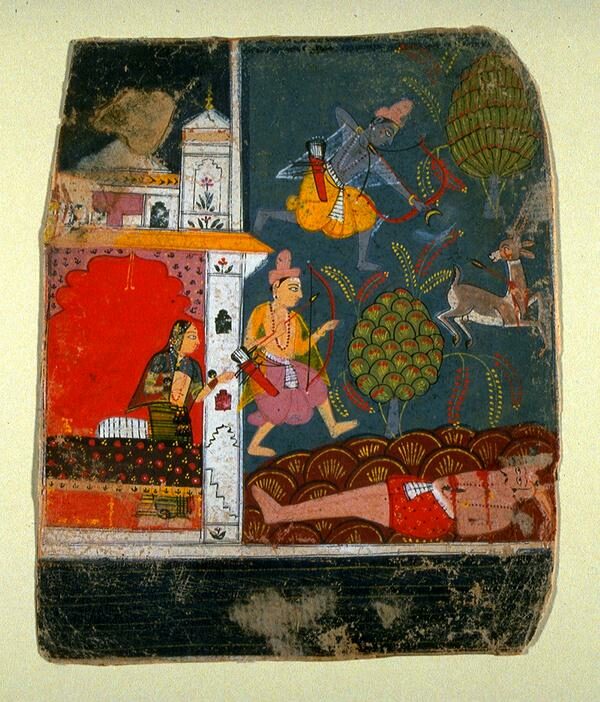Râmâyana manuscript page: Rama kills the deer (folio no. 31)
Artist Unknown, India, Central India, Malwa School

Description
This scene portrays a dramatic moment in the Ramayana. The blue-skinned Rama (a human manifestation of the Hindu god Vishnu) had been unjustly exiled from his father’s kingdom to the forest, where he dwelt with his brother Lakshmana and his wife, Sita. One day a beautiful golden deer appeared and lured the men away from their forest dwelling. When Rama shot the deer, it reverted to its true shape as a demon—shown dying in the lower part of the painting. Realizing that they had been duped, the brothers raced back to the hut to find that Sita had been abducted in their absence.
The artist has captured the story of the deer hunt with the fewest possible elements, in a way that is instantly recognizable and yet takes liberties with the classical tale. The forest is represented by two trees and a few sprays of foliage; the deer is a mundane gray, not magical gold; and Sita waits anxiously in a white marble pavilion, rather than a thatched hut. The vibrantly colored backgrounds divide the composition into zones that create mood and organize the narrative.
Exhibited in "Divine Encounters, Earthly Pleasures: Twenty Centuries of Indian Art," 12/12/03-2/22/04.
---
This scene portrays a dramatic moment in the Ramayana. The blue-skinned Rama (a human manifestation of the Hindu god Vishnu) had been unjustly exiled from his father’s kingdom to the forest, where he dwelt with his brother Lakshmana and his wife, Sita. One day a beautiful golden deer appeared and lured the men away from their forest dwelling. When Rama shot the deer, it reverted to its true shape as a demon—shown dying in the lower part of the painting. Realizing that they had been duped, the brothers raced back to the hut to find that Sita had been abducted in their absence.
The artist has captured the story of the deer hunt with the fewest possible elements, in a way that is instantly recognizable and yet takes creative liberties with the classical tale. The forest is represented by two trees and a few sprays of foliage; the deer is a mundane gray, not magical gold; and Sita waits anxiously in a white marble pavilion, rather than a thatched hut. The vibrantly colored backgrounds help establish the mood of the each vignette while creating compositional zones that organize the narrative.
(6/28/10)
(South and Southeast Asia Gallery Rotation, Spring 2010)
Subject Matter:
This scene portrays a dramatic moment in the Ramayana. The blue-skinned Rama (a human manifestation of the Hindu god Vishnu) had been unjustly exiled from his father’s kingdom to the forest, where he dwelt with his brother Lakshmana and his wife, Sita. One day a beautiful golden deer appeared and lured the men away from their forest dwelling. When Rama shot the deer, it reverted to its true shape as a demon—shown dying in the lower part of the painting. Realizing that they had been duped, the brothers raced back to the hut to find that Sita had been abducted in their absence.
Physical Description:
The artist has captured the story of the deer hunt with the fewest possible elements, in a way that is instantly recognizable and yet takes liberties with the classical tale. The forest is represented by two trees and a few sprays of foliage; the deer is a mundane gray, not magical gold; and Sita waits anxiously in a white marble pavilion, rather than a thatched hut. The vibrantly colored backgrounds divide the composition into zones that create mood and organize the narrative.
Usage Rights:
If you are interested in using an image for a publication, please visit https://umma.umich.edu/request-image/ for more information and to fill out the online Image Rights and Reproductions Request Form.